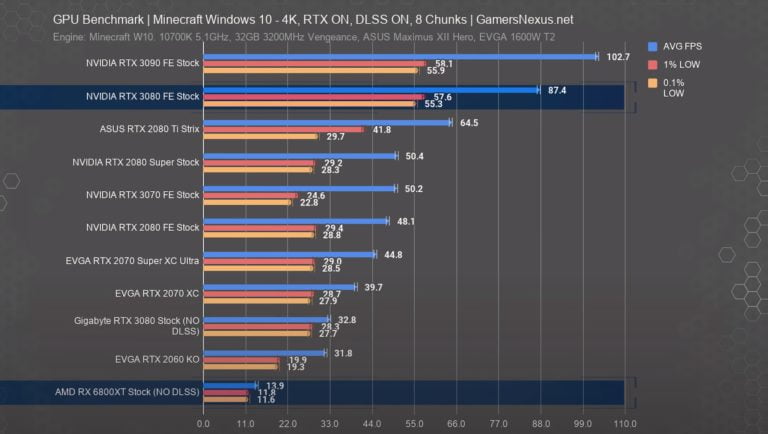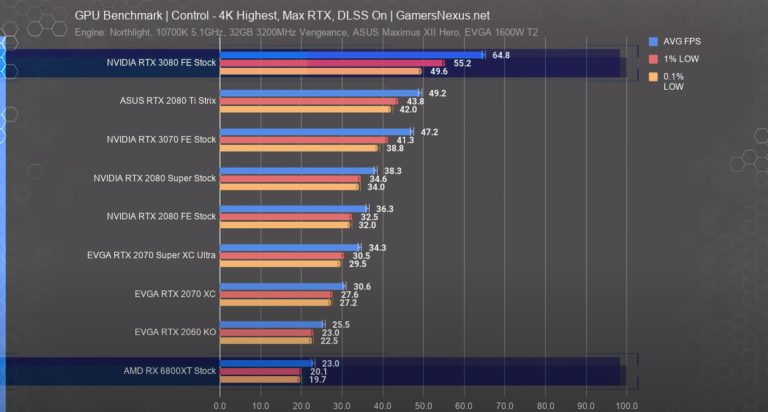AMD has released the Radeon RX 6800 and Radeon RX 6800 XT, and according to performance tests by tech websites shows that NVIDIA has a more advanced architecture.
When the RDNA 2 architecture was announced, AMD emphasized the performance of these new graphics cards in current games under rasterization, that is, it did not show information about their possible performance working with ray tracing. However, the performance tests they showed were very clear, according to the Sunnyvale company the Radeon RX 6800 was superior to the RTX 3070, and the Radeon RX 6800 XT outperformed the RTX 3080.
The results and the information given by AMD were very positive, which created expectations to normalize the prices of graphics cards in a similar way to what happened in the CPU sector after the launch of the Zen 2 architecture. But the fact that AMD did not specify figures like NVIDIA did and decided to omit performance data in ray tracing.

The performance tests published by GamerNexus, HardwareUnboxed, Kitguru and TechPowerUp! show somewhat disparate results if you limit ourselves to absolute performance. On the other hand, most of these publications agree on a number of key points that will help better understand the real value behind the Radeon RX 6800 and Radeon RX 6800.
Radeon RX 6800 specs
- Navi 21 XL graphics core in 7 nm
- 60 active CUs with 3,840 shaders
- 1815MHz-2105MHz GPU, normal and turbo mode
- 240 textured units, also dedicated to ray tracing
- 96 rasterization units
- 256-bit bus
- 16GB GDDR6 memory and 128MB infinite cache
- 250W TDP
Radeon RX 6800 XT specs
- Navi 21 XT graphics core in 7 nm
- 72 active CUs with 4,608 shaders
- GPU at 2.015MHz-2.250 MHz, normal and turbo mode
- 288 textured units, also dedicated to ray tracing
- 116 rasterization units
- 256-bit bus
- 16GB GDDR6 memory and 128MB infinite cache
- 300 Watt TDP
AMD claimed that the Radeon RX 6800 XT was superior to the RTX 3080, but this is not the case. In some tests, the Radeon RX 6800 XT even surpasses the RTX 3090, but making an average of performance the conclusion is simple: the new AMD graphics card is a little slower than the RTX 3080 by 4K (about 6%). In 1080p and 1440p there is no agreement, as some tests are leaded bu the first one, and others to the second one. Of course, we are talking about rasterized results, that is, without including ray tracing or DLSS 2.0 in the equation.

On the other hand, the Radeon RX 6800 exceeds the RTX 3070 by 4K with a margin of between 7% and 9%, according to most of the tests. In this case, the result does fit with what AMD said at the time, although the difference is less than the graphs that showed by AMD at the presentation. Again, note that ray tracing and DLSS are not included in these tests.
- GeForce RTX 3050: Ray tracing and DLSS 2.0 with an affordable price
- Intel and UCSC work on a promising alternative to NVIDIA’s DLSS
- AMD Radeon RX 6800 might run out of stock
In terms of consumption and temperature, AMD solutions are a little more efficient, but they move in temperature values similar to those recorded on the RTX 3070 and RTX 3080. Thus, the Radeon RX 6800 registers maximums of 69 to 71 degrees Celcius, while the Radeon RX 6800 XT ranges from 77 to 81 degrees Celsius. There is no agreement between the different media, but it is understandable, since the test environment and the ambient temperature have not been the same.
Lightning trace and DLSS 2.0: the value of specialization
The performance results in ray tracing shows that the Radeon RX 6800 and 6800 XTs collapse, so much so that the frame rate is reduced to a third in some cases, and the superiority of NVIDIA’s Ampere architecture becomes apparent.
The ray tracing performance of the Radeon RX 6000 is at best, at the level of the RTX 20 or a little above. NVIDIA has the upper hand in ray tracing, that’s beyond dispute, but what if you put DLSS 2.0 into the equation?
AMD has done a good job with the Radeon RX 6800 and RX 6800 XT. They are powerful, have a good energy efficiency, record great consumption values in relation to performance per watt consumed, and thanks to its 16 GB of graphics memory are outlined as an interesting option in the long term, but do not reach the level that has the Ampere architecture on two fronts that have proven to have enormous potential: DLSS 2.0 and ray tracing.
Let’s face it, DLSS 2.0 is a wonder that manages to double the performance without loss of visual quality, and even improves the finish against the native resolution in certain titles (Control and Death Stranding, for example). It is so interesting that makes an RTX 2060 can move games in 4K with maximum quality at 60 FPS totally stable, so why AMD can’t do, should be thought.




